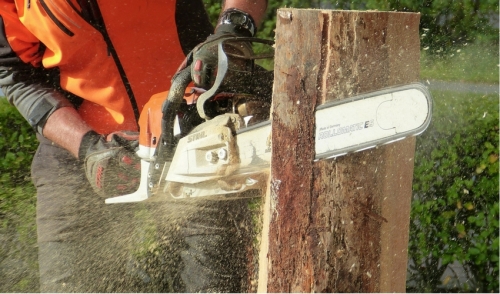{article.name}
Tips for Cutting Down Trees

- Share this:
- Share on Facebook
- Pin on Pinterest
- Tweet on Twitter
While it’s true that most homeowners with a chainsaw (and the fortitude) can cut down a tree, it should be stressed that this is a project to be approached with the utmost care. Safety is the number one concern. Not only are chainsaws dangerous, but falling trees are equally so. It stands to reason therefore, that any trees of considerable size should be dealt with by a professional. If you have any doubts, err on the side of caution and consult or hire an expert. If however, you have a small tree that needs to be removed, and you think you are up to the task, then we’ve included some tips that should make your job safer and easier.
First off, make sure that you are comfortable operating a chainsaw. They are excellent tools that can make short work of most any tree. They are however, quite dangerous and should be operated very carefully. According to the Occupational Safety and Health Administration (OSHA) you should make sure that you are wearing the proper protective gear. This includes a hard hat, eye and ear protection, long sleeve shirt and pants, work gloves and steel toed boots. When operating the saw, a general rule is to never cut anything that is above your head. Additionally, while cutting make sure your footing is secure and both hands are on the handle. For additional safety information, OSHA has a fact sheet about working safely with chainsaws that can be found here.
Preparation is very important. You should try to choose a calm day, with as little wind is possible. Survey the area from a distance to help determine which way the tree will fall. Consider the direction the tree leans or if it appears to be heavier on a certain side. For trees taller than 10 feet, it is recommended to attach a rope and apply tension in the direction that you want the tree to fall. The natural lean of the tree (or lack thereof) will determine the amount of tension that you will need to have on your rope. Lastly, look for structures wires, landscaping or anything else that could get damaged by the falling tree.
Always plan an escape route. Once the tree begins to fall, you will want an open path to exit from. If necessary, clear the area around the tree of any debris or low level branches that can get in your way.
When you begin cutting, it may be necessary to cut a hinge or wedge to direct the tree’s fall. To do so, cut at a 20° upwards angle on the side of the tree that is in the direction you wish it to fall. The depth of your cut should be equal to one quarter of the tree’s diameter. A few inches above that cut, make a second cut at a 70° downward angle until it meets your first cut, forming a wedge. Your final cut should be made on the opposite side of the tree, parallel to the ground and towards the wedge. It is a good idea to pause halfway and assess the situation. At all times, stay aware of your escape route and once the tree begins to fall, step away immediately.
OSHA has made available a list of tree trimming and removal safety tips on their website here
© 2025 Westville Grand Rental Station. All rights reserved.
Serving Southern NH and The Merrimack Valley Since 1990
View our accessibility statement
Driven by New Media Retailer

Comments